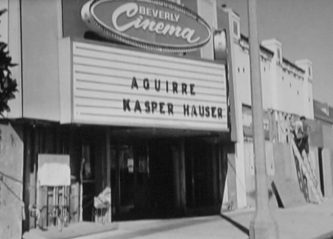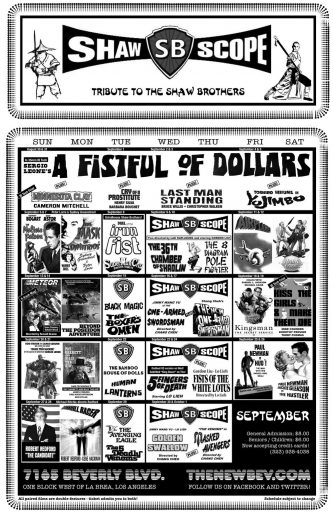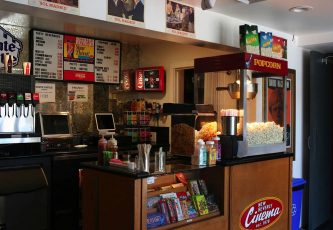 Those of you who don’t reside in Los Angeles are probably puzzled by the throwaway references we Angelinos are always making to the “New Beverly” (such as a recent facebook posting about grindhouse cinema, which the poster described as being “like the New Beverly”). We’re referring to the New Beverly Cinema, a repertory theater that in recent years has attained legendary status, in large part because of its current owner, the one and only Quentin Tarantino, and its staunch commitment to 35mm exhibition. Located on Beverly Boulevard at the eastern edge of LA’s Fairfax District, the Beverly Cinema was a porno theater taken over in 1978 by Sherman Torgan, who christened it the New Beverly Cinema, and turned it into a 37-year Los Angeles fixture.
Those of you who don’t reside in Los Angeles are probably puzzled by the throwaway references we Angelinos are always making to the “New Beverly” (such as a recent facebook posting about grindhouse cinema, which the poster described as being “like the New Beverly”). We’re referring to the New Beverly Cinema, a repertory theater that in recent years has attained legendary status, in large part because of its current owner, the one and only Quentin Tarantino, and its staunch commitment to 35mm exhibition. Located on Beverly Boulevard at the eastern edge of LA’s Fairfax District, the Beverly Cinema was a porno theater taken over in 1978 by Sherman Torgan, who christened it the New Beverly Cinema, and turned it into a 37-year Los Angeles fixture.
My own history with the New Beverly Cinema began in the late 1980s, when I caught a showing of Sergei Paradjanov’s COLOR OF POMEGRANATES. That screening was distinguished by a dunk storming out of the theater screaming “Where do they get these stupid pictures?” and a guy shining a flashlight around the auditorium shouting that he’d lost his keys. The experience more or less set the tone for my subsequent New Beverly patronage.
Frequenting the place throughout the nineties, I grew accustomed to the New Beverly’s oft-rowdy clientele and overall skuzziness (you had to watch where you sat, as I recall, as seemingly every other seat in the theater always seemed to be broken). Back then it only cost $5.00 for a double bill (now it’s $8.00), with then as now a movie showing in the 7 PM range and another at around 9 PM. The men’s room was quite tiny (as it probably still is), being large enough to accommodate a single person. Parking was generally on Formosa Avenue, the closest street to the theater, which would invariably be mobbed at the end of the night. Seeing as how I had a half hour-plus drive back to where I was living at the time, I got in the habit of getting up in the last five minutes of a movie, watching the final scenes standing in the aisle, and then dashing out and driving off before everyone else.
These days the New Beverly has become synonymous with grindhouse fare, as is evident in the Shaw Brothers flicks and spaghetti westerns (most of  them culled from Quentin Tarantino’s own collection) that currently fill its slate. This only points up how much the New Beverly’s current incarnation deviates from its pre-Tarantino one. Hard though it may seem to believe right now, during the eighties and nineties this theater was known primarily for screening foreign and arthouse fare. Certainly the New Beverly included its fair share of horror and exploitation movies—I have an especially fond memory of experiencing SUSPIRIA there in the late nineties, proving that if you haven’t seen SUSPIRIA on a big screen you haven’t really seen it—but most of what I saw at the New Beverly were films like RED DESERT, QUEEN MARGOT, AGUIRRE THE WRATH OF GOD, WALKABOUT, LA JETTEE, QUADROPHENIA, 1900 and the entire oeuvre of Andrei Tarkovsky, mini-retrospectives of which the New Beverly used to hold at least once a year.
them culled from Quentin Tarantino’s own collection) that currently fill its slate. This only points up how much the New Beverly’s current incarnation deviates from its pre-Tarantino one. Hard though it may seem to believe right now, during the eighties and nineties this theater was known primarily for screening foreign and arthouse fare. Certainly the New Beverly included its fair share of horror and exploitation movies—I have an especially fond memory of experiencing SUSPIRIA there in the late nineties, proving that if you haven’t seen SUSPIRIA on a big screen you haven’t really seen it—but most of what I saw at the New Beverly were films like RED DESERT, QUEEN MARGOT, AGUIRRE THE WRATH OF GOD, WALKABOUT, LA JETTEE, QUADROPHENIA, 1900 and the entire oeuvre of Andrei Tarkovsky, mini-retrospectives of which the New Beverly used to hold at least once a year.
Those Tarkovsky retrospectives were quite popular, getting write-ups in the L.A. Times and attracting sellout crowds. I was there for nearly every one of them (I always made sure to arrive early), which was one way in which my patronage mirrored that of the New Beverly’s clientele overall. Another was that I stopped going to the New Beverly in the 2000s, just as, it seems, did most everyone else. The DVD boom was the alleged catalyst for peoples’ defection from the New Beverly, resulting in Tarantino subsidizing Torgan (with a reported $5,000 a month) to keep the place running.
Sherman Torgan died unexpectedly on July 18, 2007, leaving his son Michael to run the theater. Tarantino intervened in a major way the following year, when the New Beverly was in danger of being foreclosed upon and turned into a Supercuts. Tarantino responded by buying the property outright, thus becoming the New Beverly’s landlord. In this guise he offered “programming suggestions,” such as the suspension of the theater’s usual programming in favor of an extended DJANGO UNCHAINED run in December 2012. That was prior to late 2014, when Tarantino took over the running of the theater altogether.
The circumstances of Quentin Tarantino’s takeover of the New Beverly have never been publicly disclosed. The most prominent rumor has it that Tarantino, a staunch proponent of 35mm projection, was pissed that Michael Torgan opted to purchase a digital projector and, in what one internet poster called an “act of fascism,” seized control. Note the slogan on the New Beverly website proclaiming “All Shows Presented in Glorious 35MM.”
 The Tarantino-ized New Beverly Cinema debuted in October 2014. There weren’t many complaints aside from a widely publicized online whine-fest by Julia Marchese, a fired New Beverly employee who lamented that the theater was being transformed into a “multiplex” due to the fact that Tarantino dared spiff the place up (her comments, for the record, have since been taken down). That refurbishment wasn’t a bad idea if you ask me, and the New Beverly has continued to thrive in the ensuing years. Marchese, for the record, has made a documentary about the New Beverly (consisting largely of talking-head interviews with famous folk who love the theater).
The Tarantino-ized New Beverly Cinema debuted in October 2014. There weren’t many complaints aside from a widely publicized online whine-fest by Julia Marchese, a fired New Beverly employee who lamented that the theater was being transformed into a “multiplex” due to the fact that Tarantino dared spiff the place up (her comments, for the record, have since been taken down). That refurbishment wasn’t a bad idea if you ask me, and the New Beverly has continued to thrive in the ensuing years. Marchese, for the record, has made a documentary about the New Beverly (consisting largely of talking-head interviews with famous folk who love the theater).
As for myself, my only real complaint with the new New Beverly Cinema is, again, the fact that its programming has changed so dramatically since the days when I frequented the place. I’m certainly not complaining about its current grindhouse orientation (any theater that plays BLACK MAGIC, THE BOXER’S OMEN and THE MIGHTY PEKING MAN in a single month, as the New Beverly did in late 2015, gets my vote), but I miss the eclectic mix of foreign, arthouse and mainstream Hollywood fare that marked the old New Beverly.
I will, however, give the New Beverly Cinema points for thriving in an age when 35mm is being phased out. Given that I grew up watching (and projecting) 35mm prints, and continue to believe it’s the ideal means of film presentation, I feel Quentin Tarantino and the New Beverly Cinema deserve praise for keeping the format alive. I also recognize they’re going to have an uphill battle in the years to come.
